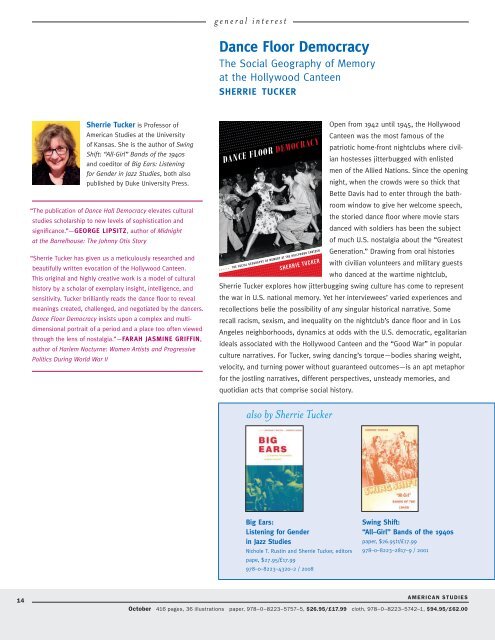x1vuD
x1vuD
x1vuD
You also want an ePaper? Increase the reach of your titles
YUMPU automatically turns print PDFs into web optimized ePapers that Google loves.
general interest<br />
Sherrie Tucker is Professor of<br />
American Studies at the University<br />
of Kansas. She is the author of Swing<br />
Shift: “All-Girl” Bands of the 1940s<br />
and coeditor of Big Ears: Listening<br />
for Gender in Jazz Studies, both also<br />
published by Duke University Press.<br />
“The publication of Dance Hall Democracy elevates cultural<br />
studies scholarship to new levels of sophistication and<br />
significance.”—GEORGE LIPSITZ, author of Midnight<br />
at the Barrelhouse: The Johnny Otis Story<br />
“Sherrie Tucker has given us a meticulously researched and<br />
beautifully written evocation of the Hollywood Canteen.<br />
This original and highly creative work is a model of cultural<br />
history by a scholar of exemplary insight, intelligence, and<br />
sensitivity. Tucker brilliantly reads the dance floor to reveal<br />
meanings created, challenged, and negotiated by the dancers.<br />
Dance Floor Democracy insists upon a complex and multidimensional<br />
portrait of a period and a place too often viewed<br />
through the lens of nostalgia.”—FARAH JASMINE GRIFFIN,<br />
author of Harlem Nocturne: Women Artists and Progressive<br />
Politics During World War II<br />
Dance Floor Democracy<br />
The Social Geography of Memory<br />
at the Hollywood Canteen<br />
sherrie tucker<br />
<br />
<br />
<br />
<br />
<br />
<br />
<br />
<br />
<br />
<br />
<br />
<br />
<br />
Dance F loor Democ racy<br />
Open from 1942 until 1945, the Hollywood<br />
Canteen was the most famous of the<br />
patriotic home-front nightclubs where civilian<br />
hostesses jitterbugged with enlisted<br />
men of the Allied Nations. Since the opening<br />
night, when the crowds were so thick that<br />
Bette Davis had to enter through the bathroom<br />
window to give her welcome speech,<br />
the storied dance floor where movie stars<br />
danced with soldiers has been the subject<br />
of much U.S. nostalgia about the “Greatest<br />
Generation.” Drawing from oral histories<br />
with civilian volunteers and military guests<br />
who danced at the wartime nightclub,<br />
Sherrie Tucker explores how jitterbugging swing culture has come to represent<br />
the war in U.S. national memory. Yet her interviewees’ varied experiences and<br />
recollections belie the possibility of any singular historical narrative. Some<br />
recall racism, sexism, and inequality on the nightclub’s dance floor and in Los<br />
Angeles neighborhoods, dynamics at odds with the U.S. democratic, egalitarian<br />
ideals associated with the Hollywood Canteen and the “Good War” in popular<br />
culture narratives. For Tucker, swing dancing’s torque—bodies sharing weight,<br />
velocity, and turning power without guaranteed outcomes—is an apt metaphor<br />
for the jostling narratives, different perspectives, unsteady memories, and<br />
quotidian acts that comprise social history.<br />
Sherrie Tucker<br />
The Social GeoGraphy of MeMory aT The hollywood canTeen<br />
<br />
<br />
<br />
<br />
<br />
<br />
<br />
<br />
<br />
<br />
<br />
<br />
<br />
also by Sherrie Tucker<br />
Big Ears:<br />
Listening for Gender<br />
in Jazz Studies<br />
Nichole T. Rustin and Sherrie Tucker, editors<br />
pape, $27.95/£17.99<br />
978–0–8223–4320–2 / 2008<br />
Swing Shift:<br />
“All–Girl” Bands of the 1940s<br />
paper, $26.95tr/£17.99<br />
978–0–8223–2817–9 / 2001<br />
14<br />
AMERICAN STUDIES<br />
October 416 pages, 36 illustrations paper, 978–0–8223–5757–5, $26.95/£17.99 cloth, 978–0–8223–5742–1, $94.95/£62.00


